It is, after all, a mobile mansion.
Yesterday, I repositioned my fifth wheel RV, the “mobile mansion,” from an RV park at the Colockum Ridge Golf Course in Quincy, WA to a residential construction site high on a hill on the east side of Squilchuck Valley. The site is across the street from an 86-acre orchard I’m responsible for drying with my helicopter after it rains for the next few weeks.
The Move
Moving an RV you’ve been living in for two months isn’t as easy as just hooking up and rolling out. The first step is to put away all the loose objects you’ve been living with for that time — loose objects will get tossed around in transit. I had to stow my desktop computer in its box to protect it, clear my desk and table and kitchen countertops, stow shelf items — the list goes on and on. Even the small tabletop lamp beside my La-Z-Boy rocker needed to be stowed.
Of course, since I was putting things away, I felt compelled to dust and vacuum. The benefit is that when I arrive at my new parking spot, my home will be clean.
Then comes strapping down the items that can’t be stowed: my swing-arm mounted 36-inch HDTV, the La-Z-Boy, and Alex the Bird’s cage. The RV comes with straps for all of these things. (Alex’s cage sits where the second La-Z-Boy would be.)
Outside, I needed to take down my windsock and its 14-foot pole. (I had to use pipe wrenches to get the three pipe segments separated.) Stow the bird feeder and grill. Take down the outside sun shades, hose them off, and hang them to dry — then stow them when dry. Roll up the awning. Dump the gray and black water. Wash and stow the sewer hose. Disconnect the water and power and stow the hoses and cables.
Use the remote to slide in the RV’s four slides, raise the stabilizer legs, and lower the landing gear. Back the pickup into position — by myself, mind you — and raise the landing gear to drop the hitch on top of the ball. (Yes, this is a fifth wheel trailer, but we put a gooseneck adapter on it since we already had a gooseneck hitch in the bed of the pickup.) Fasten the pin, chains, and power cord.
 I use an app on my iPad to list and check off the things I need to do. It’s called RV Checklist and although its not as slick looking as a typical iOS app, it does give me the ability to create and use custom checklists. The benefit: I can include items like “Take down windsock” and “Secure bird cage,” which are not likely to appear on any standard check list. I can also remove items I don’t need, such as “Disconnect satellite dish” and “Hook up towed vehicle.”
I use an app on my iPad to list and check off the things I need to do. It’s called RV Checklist and although its not as slick looking as a typical iOS app, it does give me the ability to create and use custom checklists. The benefit: I can include items like “Take down windsock” and “Secure bird cage,” which are not likely to appear on any standard check list. I can also remove items I don’t need, such as “Disconnect satellite dish” and “Hook up towed vehicle.”
On the Road
 Once the trailer was hooked up and the chocks were collected and stowed, I loaded my potted tomato plant and Alex the Bird into the truck and headed out.
Once the trailer was hooked up and the chocks were collected and stowed, I loaded my potted tomato plant and Alex the Bird into the truck and headed out.
Driving a 3/4 ton pickup with a 34-foot fifth wheel trailer behind it isn’t something to be taken lightly. Every turn needs to be considered. Every downhill slope needs to be approached with care. And driving in city traffic can really pump up stress levels.
My drive wasn’t long — only about 50 miles. The first 35 miles was two-lane state highway with little traffic, 60 miles per hour speed limit, and passing lanes every 5 to 10 miles. Easy going. The next 5 or so miles, however, was city driving through East Wenatchee, over the Columbia River, and into Wenatchee. This is tense stuff for me because, with my load, driving defensively is not much of an option. I have to keep to my lane and hope no one around me drives like a jerk. Then the final 10 or so miles was up windy canyon roads. Yesterday was a special challenge — a detour onto a narrower, windier road. Fortunately, traffic wasn’t an issue.
After two turns, I climbed up the last road to my destination. The pavement turned to fine gravel. A quarter mile later, was the circle of a former cul-de-sac, now with a narrow dirt road leading farther up the side of the valley. My parking spot was a sharp right turn down a steep dirt hill. Since I’d be backing into it, I pulled up into the far side of the cul-de-sac and got out to set my cones.
Parking
I have a trick I use to back up the RV by myself. I have four small orange traffic cones. I set them out as guides to where I want to park the RV. I can clearly see them in my side view mirrors. All I have to do is line up the side of the RV with the cones and I can get it into position.
Of course, this site required quite a lengthy roll back. As a result, I had to set the cones out once, back almost all the way to the last one, and then get out of the truck and set the cones again. The last little bit was particularly challenging, since I’d be positioning the RV between the edge of a cliff and the home under construction. I managed to get it in place without too much difficulty — this surprised me because, by that point, I was completely exhausted. I’d been on the move all day and it was about 6:30 PM.
Before disconnecting, I needed to make sure the RV was level. After consulting the level right inside the RV’s door, I decided that three leveling blocks would do the job. I positioned them and rolled the RV back on top of them. Although I probably could have been a bit more level with just two blocks, this was good enough. Besides, I knew from experience that if it rained, the blocks would sink a bit into the ground beneath them. That would likely make me perfectly level.
Then lower the landing gear, disconnect the hitch and its chains/cable, and pull the truck out. Raise the landing gear to level the RV. Slide out the slides. Good to go. I’d pull out the things I needed as I needed them over the next few days.
Later, after a shower to wash away the day’s dirt and sweat, I ran a power cord to the 110 volt outlet on the homesite’s electric box. This power connection is a far cry from the 50 amp power supply at the campground. I know I won’t be able to run certain appliances at the same time — for example, the microwave and air conditioner. But at least I won’t have to rely on the RV’s solar panel or run the generator for power.
My Campsite
I stayed here last year for the first time. Back then, the only sign of construction was a building foundation and the concrete pouring forms that had been used to make it. This year, there’s a small, two story vacation home framed out and roofed. The siding should go on this week; the windows, which have been delivered, will go up soon, too. Then construction will stop for the season. The owner of the property is paying for construction as it is completed and he says he’s out of money.
A time-lapse movie I shot last year from this spot.
My parking spot is literally on the edge of a cliff — the ground drops off about 10 feet past my door. The views out the side and back window are spectacular. Across the valley are scattered pine trees, granite rock outcroppings, and orchards. Sunrise is amazing; golden light creeping down the hillside. And back toward Wenatchee, I can see the Columbia River and Rocky Reach Dam, which are all lit up at night.
 My helicopter is parked down in the orchard. I tried to park it near my campsite, but I couldn’t find a piece of ground level enough to make me comfortable leaving it there. I might try moving it again later today — I really don’t like it being out of sight. Wish I could get my hands on a Bobcat for a few hours to level out a piece of this hilly homesite.
My helicopter is parked down in the orchard. I tried to park it near my campsite, but I couldn’t find a piece of ground level enough to make me comfortable leaving it there. I might try moving it again later today — I really don’t like it being out of sight. Wish I could get my hands on a Bobcat for a few hours to level out a piece of this hilly homesite.
I wonder what will happen next year. Will the house be done? Will the owner tell me that there’s no room for an RV in his side yard? Will I be parked down in the orchard beside my helicopter and the scummy pond, hauling fresh water and running a generator every day? I hope not. But I won’t worry about that now. I’ll just enjoy this year’s hillside campsite.
Today, I’ll hook up the water connection and set up the gray water to drain away from the RV. (I’ve already switched to biodegradable soaps to minimize impact.) Then I’ll head down to Wenatchee and do some shopping.
I’m glad I’m up here. Although this location is lonely and remote at night, there’s activity during the day on the house construction nearby and on the orchard. And I can’t imagine a more pleasant place to park.



 I use Weather Bug on my iPad and WeatherBug Elite on my iPhone. They usually have the same forecast.
I use Weather Bug on my iPad and WeatherBug Elite on my iPhone. They usually have the same forecast.
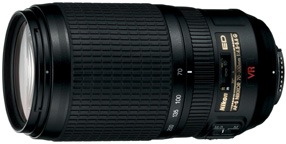 Telephoto lens. I have a Nikon ED AF-S Nikkor 70-300mm 1:4.5-5.6 G VR lens that I use for just about all of my bird photography. Again, not a professional lens and, as some have argued, not even a long enough lens for serious wildlife photography. But hell, this is a hobby. You have to draw the line somewhere. What makes this lens especially useful is the vibration reduction (VR) feature, which kicks in as necessary when turned on.
Telephoto lens. I have a Nikon ED AF-S Nikkor 70-300mm 1:4.5-5.6 G VR lens that I use for just about all of my bird photography. Again, not a professional lens and, as some have argued, not even a long enough lens for serious wildlife photography. But hell, this is a hobby. You have to draw the line somewhere. What makes this lens especially useful is the vibration reduction (VR) feature, which kicks in as necessary when turned on.
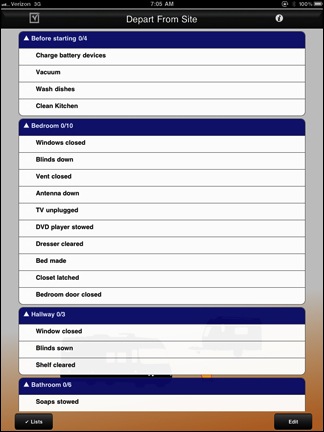 I use an app on my iPad to list and check off the things I need to do. It’s called
I use an app on my iPad to list and check off the things I need to do. It’s called 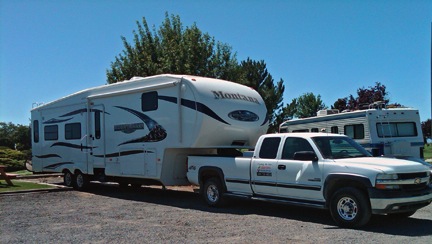 Once the trailer was hooked up and the chocks were collected and stowed, I loaded my potted tomato plant and Alex the Bird into the truck and headed out.
Once the trailer was hooked up and the chocks were collected and stowed, I loaded my potted tomato plant and Alex the Bird into the truck and headed out.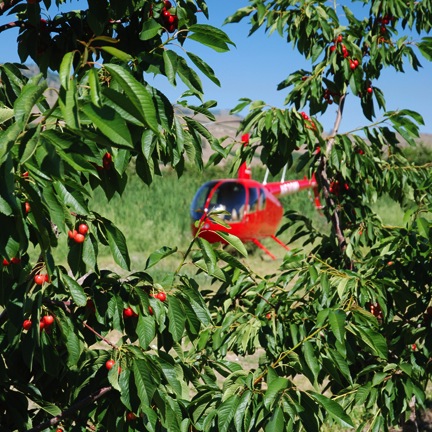 My helicopter is parked down in the orchard. I tried to park it near my campsite, but I couldn’t find a piece of ground level enough to make me comfortable leaving it there. I might try moving it again later today — I really don’t like it being out of sight. Wish I could get my hands on a Bobcat for a few hours to level out a piece of this hilly homesite.
My helicopter is parked down in the orchard. I tried to park it near my campsite, but I couldn’t find a piece of ground level enough to make me comfortable leaving it there. I might try moving it again later today — I really don’t like it being out of sight. Wish I could get my hands on a Bobcat for a few hours to level out a piece of this hilly homesite.
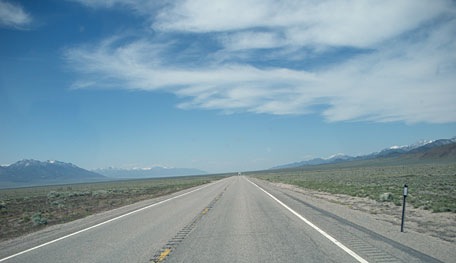 At 6:45 AM, I was in the driver seat of the truck with Alex the Bird in the seat beside mine. We were starting a 1,295-mile drive from Wickenburg, AZ to Quincy, WA. My goal was to make Jackpot, NV that first day — a distance of 725 miles. I spent most of those miles on Route 93, a two-lane road with speed limits up to 70 miles per hour. There was no traffic and certain stretches of the road were straight and flat as far as the eye could see. We made Jackpot before nightfall. After dinner n the casino, I spent the night in the RV with Alex in comfort — in the casino parking lot.
At 6:45 AM, I was in the driver seat of the truck with Alex the Bird in the seat beside mine. We were starting a 1,295-mile drive from Wickenburg, AZ to Quincy, WA. My goal was to make Jackpot, NV that first day — a distance of 725 miles. I spent most of those miles on Route 93, a two-lane road with speed limits up to 70 miles per hour. There was no traffic and certain stretches of the road were straight and flat as far as the eye could see. We made Jackpot before nightfall. After dinner n the casino, I spent the night in the RV with Alex in comfort — in the casino parking lot. The next morning, I woke at 6:15, which is late for me. Anxious to get on the road, I rushed around making my coffee and Alex’s breakfast and then buttoning up the RV for another day on the road. It wasn’t until after I topped off the fuel tank across the street from the casino that I realized it was an hour earlier; that part of Nevada is on Mountain Daylight Time. So I got a very early start. I left Route 93 behind in Twin Falls, ID, and hopped on I-84. The route was mountainous and the truck sucked diesel at an alarming rate as I struggled to maintain speed up hills. I left the interstate just past Pendleton and got back on smaller, traffic-free back roads to head north. After 10 miles on I-70 and the last five miles through familiar farmland, I rolled into the parking lot at the Colockum Ridge Golf Course RV Park just after 3 PM.
The next morning, I woke at 6:15, which is late for me. Anxious to get on the road, I rushed around making my coffee and Alex’s breakfast and then buttoning up the RV for another day on the road. It wasn’t until after I topped off the fuel tank across the street from the casino that I realized it was an hour earlier; that part of Nevada is on Mountain Daylight Time. So I got a very early start. I left Route 93 behind in Twin Falls, ID, and hopped on I-84. The route was mountainous and the truck sucked diesel at an alarming rate as I struggled to maintain speed up hills. I left the interstate just past Pendleton and got back on smaller, traffic-free back roads to head north. After 10 miles on I-70 and the last five miles through familiar farmland, I rolled into the parking lot at the Colockum Ridge Golf Course RV Park just after 3 PM.
 I left Wenatchee Heights with my 5th wheel RV hooked up behind my husband’s Chevy pickup. The first day’s drive was relatively short: from Wenatchee Heights to Walla Walla, a distance of only 190 miles. Only a small portion of the drive was on a freeway (I-90); the rest was on back roads through farmland.
I left Wenatchee Heights with my 5th wheel RV hooked up behind my husband’s Chevy pickup. The first day’s drive was relatively short: from Wenatchee Heights to Walla Walla, a distance of only 190 miles. Only a small portion of the drive was on a freeway (I-90); the rest was on back roads through farmland. In Walla Walla, I stayed at the
In Walla Walla, I stayed at the  On Friday night, I got the trailer hooked up again and mostly ready to go. I needed to be on the road early for the next leg of my trip: from Walla Walla, WA to Draper, UT (south of Salt Lake City), a distance of 606 miles. I was on the road not long after dawn. The route took me south almost to Pendleton, OR, then onto I-84 through Oregon and Idaho and down into Utah, where I picked up I-15. The landscape started with farmland, then mountains, then more flat farmland, then more mountains, and then finally into the Salt Lake basin. I’d driven the route before with my underpowered Ford F150 pickup towing my old 22-foot Starcraft. It wasn’t fun then; Saturday’s drive was much more tolerable. I stopped three times for fuel and twice for food. It was very unlike me to make so many stops; I usually try to get food and fuel on the same stop, but the situation made that tough. I rolled into Draper, UT’s Camping World parking lot at 6:15 PM local time, just 15 minutes after the store closed. I’d called the week before and knew I could park out back, so I did. I even got to hook up 50 amp power.
On Friday night, I got the trailer hooked up again and mostly ready to go. I needed to be on the road early for the next leg of my trip: from Walla Walla, WA to Draper, UT (south of Salt Lake City), a distance of 606 miles. I was on the road not long after dawn. The route took me south almost to Pendleton, OR, then onto I-84 through Oregon and Idaho and down into Utah, where I picked up I-15. The landscape started with farmland, then mountains, then more flat farmland, then more mountains, and then finally into the Salt Lake basin. I’d driven the route before with my underpowered Ford F150 pickup towing my old 22-foot Starcraft. It wasn’t fun then; Saturday’s drive was much more tolerable. I stopped three times for fuel and twice for food. It was very unlike me to make so many stops; I usually try to get food and fuel on the same stop, but the situation made that tough. I rolled into Draper, UT’s Camping World parking lot at 6:15 PM local time, just 15 minutes after the store closed. I’d called the week before and knew I could park out back, so I did. I even got to hook up 50 amp power. On Sunday, @AnnTorrence picked me up for a drive to Ft. Bridger, WY. There was a
On Sunday, @AnnTorrence picked me up for a drive to Ft. Bridger, WY. There was a 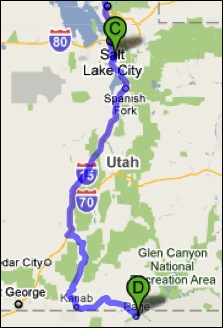 Monday — Labor Day — was my last drive day. I drove from Draper, UT to Page, AZ, a distance of 370 miles. I got a very early start, pulling out of the parking lot at 6:30 AM local time. By the time I stopped for fuel two hours later, I’d already gone more than 100 miles. (I parked with the big rig trucks and discovered that my rig was about as long as theirs.) This part of the drive was mostly on I-15, but started east on route 20 to Highway 89, which took us all the way to Page. The roads were mountainous and there was a lot of climbing and descending. There were also a lot more vehicles on the road, making driving a bit more of a chore.
Monday — Labor Day — was my last drive day. I drove from Draper, UT to Page, AZ, a distance of 370 miles. I got a very early start, pulling out of the parking lot at 6:30 AM local time. By the time I stopped for fuel two hours later, I’d already gone more than 100 miles. (I parked with the big rig trucks and discovered that my rig was about as long as theirs.) This part of the drive was mostly on I-15, but started east on route 20 to Highway 89, which took us all the way to Page. The roads were mountainous and there was a lot of climbing and descending. There were also a lot more vehicles on the road, making driving a bit more of a chore. The only food stop I made along the way was at the Thunderbird Restaurant at Mount Carmel Junction. The place is a bit of a tourist trap, but it does have good “ho-made” pies (whatever that means). Odd thing happened when I tried to leave. They couldn’t give me a bill because the computer was down. Apparently no one knows how to do basic math. All I had was a piece of pie with ice cream and an iced tea. They apparently expected me to wait until the computers came back online. With Alex the Bird in the front seat of the car, that was not an option. Finally, my waitress disappeared into the kitchen where she may have used her “lifeline” to get help with this difficult math problem. The verdict was $7.79. I was afraid to count my change.
The only food stop I made along the way was at the Thunderbird Restaurant at Mount Carmel Junction. The place is a bit of a tourist trap, but it does have good “ho-made” pies (whatever that means). Odd thing happened when I tried to leave. They couldn’t give me a bill because the computer was down. Apparently no one knows how to do basic math. All I had was a piece of pie with ice cream and an iced tea. They apparently expected me to wait until the computers came back online. With Alex the Bird in the front seat of the car, that was not an option. Finally, my waitress disappeared into the kitchen where she may have used her “lifeline” to get help with this difficult math problem. The verdict was $7.79. I was afraid to count my change. My husband, who’d flown up in his plane and spent a few hours swimming in the lake, met me at the lodge restaurant for lunch. Afterwards, we put fuel in the truck and parked it (temporarily) at Page Municipal Airport. I gathered my belongings — forgetting only two things, one of which was vital — and we loaded into Mike’s plane. Then we started the long (90 minutes), hot (90°F+), and bumpy (I almost got sick) flight to Wickenburg. The only sights of interest along the way — keeping in mind that I make that flight about 1000 feet lower at least a dozen times a year — were a handful of forest fires east of our Howard Mesa place and a heavy rain shower coming out of a remarkably small cloud near Granite Mountain.
My husband, who’d flown up in his plane and spent a few hours swimming in the lake, met me at the lodge restaurant for lunch. Afterwards, we put fuel in the truck and parked it (temporarily) at Page Municipal Airport. I gathered my belongings — forgetting only two things, one of which was vital — and we loaded into Mike’s plane. Then we started the long (90 minutes), hot (90°F+), and bumpy (I almost got sick) flight to Wickenburg. The only sights of interest along the way — keeping in mind that I make that flight about 1000 feet lower at least a dozen times a year — were a handful of forest fires east of our Howard Mesa place and a heavy rain shower coming out of a remarkably small cloud near Granite Mountain.